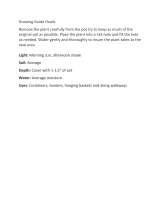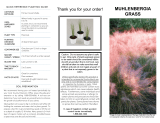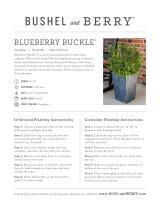
**IImmaaggee oonn ccoovveerr iiss rreepprreesseennttaattiivvee ooff tthhee ttyyppee ooff ppllaanntt((ss)) iinn tthhiiss ooffffeerr aanndd
nnoott nneecceessssaarriillyy iinnddiiccaatti
ivvee ooff aaccttuuaall ssiizzee oorr ccoolloorr ffoorr tthhee iinncclluuddeedd vvaarriieettyy
.
BBLLAACCKKBBEERRRRIIEESS
Bearing plump, juicy berries on thornless canes,
these hardy blackberry varieties are ideal for any
garden. Whether baked in cookies, cakes or
pies, or enjoyed as a fresh snack, these tasty
berries will delight your taste buds!
Caution:
Do nnot aassume aany pplant iis ssafe tto eeat.
Only pparts oof pplants eexpressly ggrown tto bbe eeaten
should bbe ccons
idered eedible. AAs wwith aany pproduct
that iis nnot ffood, ccare sshould bbe ttaken tto mmake
sure tthat ssmall cchild
ren aand ppets ddo nnot iingest
any ppart oof aa pplant tthat iis nnot eexpressly ggrown tto
be eeaten.
Unless specifically stated, this product is
intended for ornamental horticultural use only
and is not intended for consumption or ingestion
by humans or pets. Most plants are harmless
but some contain toxic substances which can
cause adverse health effects. Furthermore, some
individuals and some animals are sensitive or
allergic to certain plants and precautions should
be taken to limit or avoid physical contact with
particular plants. Some plants have thorns or
spines that can be painful if handled.
In ccase oof iingestion ccontact aa ppoison
control ccenter iimmediately.
1-8800-2222-11222
Full sun to part shade.
LIGHT/SUN
EXPOSURE
USDA HHARDINESS
ZONES
PLANTING
DISTANCE
IN-GGROUND
MATURE
HEIGHT // SSPREAD
Arapaho:
6 feet tall with a 4 foot
spread.
Natchez:
5 feet tall with a 4 foot
spread.
Navaho:
5 feet tall with a 4 foot
spread.
Ouachita:
6 feet tall with a 3 foot
spread.
Spring.
Edible fruit.
Berries ripen in midsummer.
Great for cooking or eating fresh.
BLOOM TTIME
TIME TTO RREACH
MATURITY
FACTS OOF NNOTE
PLANT TTYPE
Perennial.
CONTAINER SSIZE
One plant per 12-inch or larger
container.
12 to 24 months.
QUICK REFERENCE PLANTING GUIDE
Thank yyou ffor yyour oorder!
Arapaho:
4 to 9.
Natchez:
4 to 9.
Navaho:
6 to 10.
Ouachita:
6 to 9.
At least 4 feet apart.
VARIETAL INFORMATION
A chill hour is equal to one hour a plant spends in temperatures
ranging from 32-45°F. The amount of chill hours required varies
between varieties. If a plant does not experience enough chill
hours during winter, its flower buds may not open in spring.
Arapaho:
400 to 500 chill hours.
Natchez:
400 to 500 chill hours.
Navaho:
800 chill hours.
Ouachita:
300 to 500 chill hours.

PLANTING INSTRUCTIONS
FFEEEEDDIINNGG
Feed your plants once every 2-3 weeks during the
growing season with a water soluble fertilizer for fruits
and vegetables. Discontinue feeding after September
1st so your plants can harden off for winter dormancy.
Resume fertilizing when new growth appears in the
spring.
PPRRUUNNIINNGGHHAARRVVEESSTTIINNGGWWIINNTTEERRIIZZIINNGG
Watering thoroughly in late fall will greatly enhance
your plant's cold tolerance once the ground has frozen.
Blackberries should be winterized in late fall. In
extremely cold areas, the canes of each plant may be
tied together and wrapped in burlap. Keep in mind
that the root system is the most vulnerable to cold
damage. Mulch heavily by mounding a 6-8 inch layer of
loose soil, shredded bark, compost, leaves, straw or
other organic material around the base of each plant.
In very cold areas, containerized plants can be brought
into an unheated, protected area such as a garage or
cellar before temperatures drop below freezing. Check
soil moisture every 2-3 weeks and water as needed
during winter.
In spring, remove mounded soil or mulch from in-
ground plantings. Containerized plants should be
moved back out into the garden sunlight where they
will begin to repeat their yearly garden performance.
CONTINUING CARE (Continued)
Important:
Thoroughly hydrate the plant by submersing the
root zone in a container of water for 10 minutes while you
prepare for planting.
1. Remove and discard the clear plastic bag from around the
pot.
2. After watering, remove the pot by holding the plant upside
down in one hand and squeezing the sides of the pot with the
other.
3. Prepare the root ball for planting by gently disturbing the
surface roots with your fingers, fork, or gardening tool and
pruning any damaged roots. This will encourage the roots to
begin growing outward into the new soil.
4. Dig a hole twice as deep and twice as wide as the plant's
root ball. Partially backfill the hole with soil and place the
plant into the hole. The top of the root ball should be level
with the ground surrounding the hole. Refill the hole with soil,
firming the soil around the plant with your fingers. Check to
be sure the plant is not planted too deeply. If it is, raise the
plant carefully and re-firm the soil.
5. Water thoroughly.
We recommend having your soil tested periodically by your
local County Extension Office (www.nifa.usda.gov/extension
or by calling 1-800-333-4636). A soil test can determine if your
soil needs any amendments to enhance the growth and
performance of your plants.
Ideal garden soil is easy to dig in and drains well while still
holding the nutrients and water vital to plant growth. To
prepare a bed for in-ground planting, spade or till the soil to
a depth of roughly 12-18 inches. Next, spread a 2-4 inch layer
of organic matter such as compost, shredded leaves or peat
moss over the soil and mix well.
SOIL PREPARATION
CONTINUING CARE
Blackberries produce fruit on canes that are one year
old. These canes will die after fruiting, then new canes
will emerge in spring to replace them. In early spring,
prune off any dead canes to allow new growth to
flourish, cutting them off at the base of the plant. Trim
any dead, damaged, or unsightly growth as needed
throughout the season to maintain an attractive
appearance and a healthy plant.
Adequate and consistent watering is essential during
your plant's first year in the garden. Infrequent, long
soakings of water that thoroughly saturate the soil are
more effective than frequent, light applications of water.
Due to variable geographical and environmental
conditions, a specific watering schedule is difficult to
define. However, as a rule of thumb, you should not
allow the soil or the original root ball to completely dry
out. During the first summer, you may need to water as
often as every few days in periods of drought and
extreme summer heat. To determine if your plant
needs water, dig a few inches into the soil next to the
plant. If the soil is dry 2-3 inches below the surface, it is
time to water.
Overwatering can be as damaging as under watering.
Be sure that the area surrounding your plant has
adequate drainage to move water away from the plant.
If you choose to plant in a container, always select one
with drainage holes to prevent your plant's roots from
sitting in water.
WWAATTEERRIINNGG
Apply a 2-4 inch layer of shredded bark, compost,
leaves, straw or other organic matter around your
plants to promote moisture retention, maintain even
soil temperatures and discourage weed growth.
Replenish the mulch as needed.
MMUULLCCHHIINNGG
Keep the area around your plants free of weeds. Weeds
compete with surrounding plants for food, water and
light. Walk around the garden periodically and pull
weeds, including the roots, as soon as you see them.
Pick blackberries when the fruits have changed from
green to black but still feel firm. When ripe, the berries
should easily detach from the plant. Harvesting early in
the morning while the weather is cool prolongs the
shelf life of the berries. After picking, store the berries
in a refrigerator and do not wash them until you are
ready to use them. The sweet, nutritious berries can be
eaten fresh, preserved or used for cooking. Do not
consume any other part of the plant.
WWEEEEDDIINNGG
OUT OF THE BOX
Your plants have been shipped to you in pots. Please remove
the plants from the packaging right away and plant them as
soon as possible following the planting instructions below. If
it is not possible to plant them right away, follow these impor-
tant steps:
1. Roll the plastic down around each plant and place them in
a sunny location.
2. Keep the plants well watered.
Note: Some leaves may appear wilted or yellow upon arrival.
This is due to the stress of shipping and is nothing to worry
about. Water the plant and let it recover for few days, then
gently remove any foliage that does not recover to allow for
new growth.
BLACKBERRIES
SHIPPED AAS SSHOWN
-
 1
1
-
 2
2
BUSHEL AND BERRY HD7054 User manual
- Type
- User manual
Ask a question and I''ll find the answer in the document
Finding information in a document is now easier with AI
Related papers
Other documents
-
National Plant Network HD7419 User manual
-
National Plant Network HD2032 User manual
-
 Daylily Nursery 6948615640 User manual
Daylily Nursery 6948615640 User manual
-
National Plant Network HD7418 User manual
-
National Plant Network HD1038 User manual
-
National Plant Network HD1126 User manual
-
OnlinePlantCenter C274CL User guide
-
OnlinePlantCenter R003CL User manual
-
 Cottage Farms Direct HD1008 User manual
Cottage Farms Direct HD1008 User manual
-
OnlinePlantCenter V4169G1 User manual








